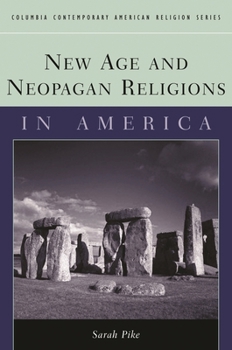New Age and Neopagan Religions in America
(Part of the Columbia Contemporary American Religion Series)
Select Format
Select Condition 
Book Overview
From Shirley MacLaine's spiritual biography Out on a Limb to the teenage witches in the film The Craft, New Age and Neopagan beliefs have made sensationalistic headlines. In the mid- to late 1990s,... This description may be from another edition of this product.
Format:Hardcover
Language:English
ISBN:0231124023
ISBN13:9780231124027
Release Date:July 2004
Publisher:Columbia University Press
Length:256 Pages
Weight:1.05 lbs.
Dimensions:0.7" x 6.4" x 9.3"
Customer Reviews
2 ratings
excellent, but mostly about the west coast
Published by Thriftbooks.com User , 17 years ago
As a fellow academic in sociology and religion, I am familiar with Pike's work in general. She is an excellent scholar and one of the foremost authorities on alternative religion. However, I will spare you all the tedium of academic discourse and instead make one critique: the book is mostly about new age and neopagan religions as manifested on the west coast of the US. As a scholar of midwest alternative religion, I think her book would benefit greatly from a visit to Chicago and Detroit for example, where paganism and other forms of alternative religion are equally manifest--but with some significant differences. Other areas of the country likely exhibit unique characteristics as well. Still, I strongly recommend the book for academic readers as well as practitioners and other students of religion.
Highly Recommended for General and Student Readership
Published by Thriftbooks.com User , 19 years ago
Sarah Pike's 2004 study is an accessible, enjoyable, very general overview of New Age and Contemporary Pagan religion in the United States. It is intended for students and interested non-students, rather than the religionist per se, and is written from a balanced, critical point of view. Her introduction provides a quick guide to most other major works of this kind, including Graham Harvey's study, and is a vast improvement over other, more polemical studies, such as Philip Davis's "The Goddess Unmasked." Pike's biggest challenge, and a controversial one, is to include yet separate New Age and Pagan religion from each other. Her efforts are probably more successful in this area than other attempts to either totally distinguish them or collapse them together. What makes Pike's study different is that her goal is not to provide a comprehensive guide to traditions and practices. Rather, her work concentrates on situating the contours of these religions in an American historical context, and demonstrating their continuity, as well as divergence, from other aspects of American Religious History. As well her main areas of investigation are trends in in healing, gender/sexuality, apocalypticism/millenialism, and in the ethics or style of practice, rather than content or specific denominations. This is significant because New Age and Neopagan religions are radically decentralized movements. Lacking a single charasmatic leader, or even one authoritative organization, these movements are for the most part, difficult to study. Unlike early century or 19th century esotericisms, they lack founding texts, or single leaders. Pike begins by spending a chapter compressing and extending, in parts, America's unchurched religious traditions, including Spiritualist trance, which she considers a significant antecedent to Pagan possession and New Age channeling. We know that Spiritualist demonstrations were attended by many, including Abraham Lincoln, Mary Todd Lincoln, Harriet Beecher Stowe, and James Fenimore Cooper. One of the major ways spirits communicated in Spiritualism was by "rapping," or making noises then interpreted in a narrative fashion. As well, Spiritualist publications and proponents were widely known to engage in ethical advocacy of issues of the day, including the treatment of Amerindians, liberal causes such as death penalty reform, and wage reform, causes advocated by many (but not all) New Agers and Pagans. While discussing Neolithic and Jungian approaches in Pagan myth, Pike firmly locates these traditions as emerging from mid-20th century revivals and transformations of 19th century (and earlier modes of religious expression), even as many Pagans trace their deities directly to classical sources. Pike correctly traces the focus on personalization in this form of religion to the highly personal, ecstatic, and optimistic ways Americans have historically related to sacred power, such as reformist movements and the Great Awakenings. One debatable




